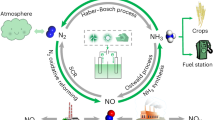Abstract
A method is described for electrodepositing181Hf from urea-oxalate aqueous bath. The optimum conditions were determined by studying the effects of current density, time of deposition and the cathode metals. More than 80% of181Hf is deposited on a nickel cathode in one hour.
Similar content being viewed by others
References
Joshi B M and Bhatki K S 1968J. Radioanal. Chem. 1 331
Joshi B M and Bhatki K S 1970Nucl. Instrum. Meth. 83 226
Joshi B M and Bhatki K S 1972Proc. Thirteenth Seminar Electrochem. Karaikudi, India, (Karaikudi CECRI) p. 341
Rane A T and Bhatki K S 1972Proc. Thirteenth Seminar Electrochem. Karaikudi, India, p. 337 1973Int. J. Appl. Rod. Isotopes 24 385
Author information
Authors and Affiliations
Rights and permissions
About this article
Cite this article
Rane, A.T. Electrodeposition of hafnium from the aqueous bath. Proc. Indian Acad. Sci. (Chem. Sci.) 89, 333–336 (1980). https://doi.org/10.1007/BF02841402
Received:
Revised:
Issue Date:
DOI: https://doi.org/10.1007/BF02841402



